|
Trimble Juno T41 R
Smartphone-inspired rugged Windows Embedded Handheld or Android mobile computer with procap multi-touch gets Ultra-High Frequency RFID versions
(by Conrad H. Blickenstorfer)
Trimble added Ultra-High Frequency RFID capability to its versatile Juno T41 rugged handheld computer platform in February 2014. That means that the Juno T41 handheld—designed to be a smartphone-inspired option for 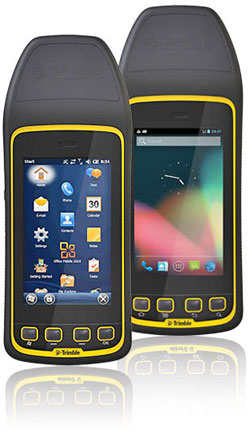 industries requiring a rugged field computer for data collection and mobile workforce management—is adding support for the rapidly growing radio frequency identification method of reading (and writing) electronic product codes. industries requiring a rugged field computer for data collection and mobile workforce management—is adding support for the rapidly growing radio frequency identification method of reading (and writing) electronic product codes.
And that's in addition to high-speed 1D/2D barcode imaging technology, smartphone capability and enhanced, real-time 1-2 meter GPS accuracy, all in a developer-friendly device for real-world field conditions, available with either Windows Embedded Handheld or the Android OS. And also in addition to being able to order the unit sealed to IP65 specifications (dustproof and able to handle low pressure water jets from all directions) OR sealed to full IP68 specification (dustproof and completely waterproof). That's impressive.
Juno T41 product family
Over time, Trimble expanded the Juno T41 into a whole family of models in three form factors and with various features. Let's discuss these a bit as form follows function and each is specialized to house certain features or combinations of features.
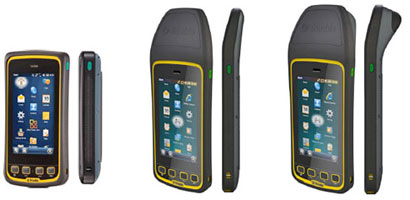
Left — the original compact form factor is available as a) the basic C model, b) the X model that includes 3.75G voice and data, and a special M model for the military.
Center — a taller, but still slender form factor is available with enhanced 1-2 meter accuracy GPS either with voice and data (XG model) or without voice and data (CG model).
Right — a second "tall" form factor with a thicker top is available in basic configuration with scanner (CS model), voice & data configuration with scanner (XS model), and voice and data configuration with both scanner and enhanced GPS (XGS model).
As of February 2014, the form factor on the right is also available in basic configuration with UHF RFID (CR model), voice & data and UHF RFID (XR model), and voice & data, enhanced GPS, and also UHF RFID (XGR model), meaning that scanner and UHF RFID are mutually exclusive.
Choice of operating platform:
Windows Embedded Handheld or Android
Unlike the consumer smartphone and tablet markets where almost all devices run either Apple's iOS or Google's Android,  the majority of vertical and industrial market devices are still based on Microsoft's older Windows Mobile (now called Windows Embedded Handheld) platform. Trimble knows that and decided to make the Juno T41 available either with Windows Embedded Handheld 6.5 or with Android (currently version 4.1, nicknamed "Jelly Bean"). Thanks to Trimble's hardware choices, the same device is available with either software platform. The two versions look identical. the majority of vertical and industrial market devices are still based on Microsoft's older Windows Mobile (now called Windows Embedded Handheld) platform. Trimble knows that and decided to make the Juno T41 available either with Windows Embedded Handheld 6.5 or with Android (currently version 4.1, nicknamed "Jelly Bean"). Thanks to Trimble's hardware choices, the same device is available with either software platform. The two versions look identical.
As far as controls go, the Juno T41 has four physical buttons below the display. In Windows based units, two of them are unmarked and relate to whatever software choices appear on the display, the other two represent the Windows and OK functions. In Android units, the four buttons are assigned to Android's standard home, menu, escape and search functions.
The Trimble Juno T41's design and technology
While the look and design of the T41 is smartphone inspired, it's larger, heavier, and much more solid than consumer smartphones. The basic unit measures 6.1 x 3.2 inches, is almost an inch thick, and weighs 13.9 ounces. The two extended form factors add a good two inches in length, and several ounces in weight. Such is the difference between a slender consumer smartphone and tough, rugged tools for outdoor jobs.
Under the hood, the Trimble T41 is based on a processor that supports both Windows and Android, the DM3730 from Texas Instruments. This is an OMAP-compatible package with an ARM Cortex-A8 core, a NEON SIMD coprocessor, and a POWERVR SGX Graphics Accelerator. The T41 can be ordered with an 800MHz version or one with a clock speed of 1GHz, with the exception of the enhanced GPS "G" models that require the faster processor.
The large 4.3-inch capacitive multi-touch display offers 480 x 800 pixel WVGA resolution, with both the touch technology and the screen resolution closer to current smartphone standards than to legacy handheld computer technology. Other impressive tech includes an 8-megapixel camera (that can automatically add time and location data from the GPS receiver), a micro-SD card slot that can accommodate cards up to 32GB, speedy 802.11n WiFi, optional 3.75G mobile broadband, and — this being a Trimble device — integrated WAAS/SBAS capable GPS with an MCX port for an optional external antenna. If the standard 2-4 meter accuracy isn't adequate for a job, Trimble offers optional real-time enhanced GPS with 1-2 meter accuracy.
For wired communication there is a special screw-on custom connector that can provide connectivity to a USB device, a 9-pin serial device or a battery charger.

Optimized UHF RFID
One issue with RFID is size. While almost all other components commonly used in mobile computers have shrunk in size to tiny modules, RFID circuitry and antennas remain relatively bulky. When searching the market for handhelds that include RFID or have an RFID option, those products often come in a pistol grip format with a large addition to house the RFID antenna and componentry. That's not necessarily a major issue, but the very goal of mobile computing is using devices that are as small, light and handy as possible. With the Juno T41 R, Trimble managed to offer a full, high-performance RFID reader in a sleek and amazingly compact package.
That's because Trimble went in-house when looking for an RFID module that met their lofty requirements. 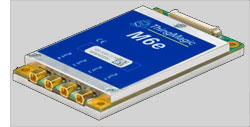 RFID specialist ThingMagic, which Trimble acquired in 2010, became the supplier of the T41 R models' embedded Mercury6e-Micro RFID module. The M6e-Micro comes in a package that measures just 46 x 26 mm. To make that possible, Trimble had ThingMagic pack the guts of their standard (and larger) M6e reader onto their smaller Micro form factor. As a result, RFID versions of the Juno T41 offer: RFID specialist ThingMagic, which Trimble acquired in 2010, became the supplier of the T41 R models' embedded Mercury6e-Micro RFID module. The M6e-Micro comes in a package that measures just 46 x 26 mm. To make that possible, Trimble had ThingMagic pack the guts of their standard (and larger) M6e reader onto their smaller Micro form factor. As a result, RFID versions of the Juno T41 offer:
- Powerful RFID reading and writing in a light and compact device.
- Orientation-insensitive integrated antenna for fast, accurate reads even with multiple tags.
- Configurable performance settings and parameters via Trimble's SearchLight app.
- SDK to customize all settings, including read-range and power consumption.
- Consistent read-range of over 12 feet for standard 2-inch UHF tags.
- Transmission at up to +30dBm (1 watt) for demanding applications.
- Support for 902-928 MHz bands (US), 920-926 MHz (Australia and New Zealand), and 865.6-867.6 MHz (Europe) bands. The T41 will be automatically configured for the proper band.
Ruggedness
As one would expect from a rugged Trimble handheld, the Juno T41 can take quite a bit of abuse. It can handle 4-foot drops to concrete without additional protection, it can handle a very wide operating temperature range of -22 to 140 degrees Fahrenheit, it carries IP65 (yellow models) or IP68 (gray models) sealing, which means it's completely impervious to dust and can either handle water jets from all directions or is totally waterproof. Trimble also lists test results for temperature shock, altitude, solar and chemical exposure, vibration and more. Between the MILD-STD-810G testing, the extremely solid construction, and the integrated protective rubber molding around the entire unit, the Juno T41 is likely to survive virtually any type of abuse.
Trimble Juno T41: An amazingly versatile platform
The February 2014 addition of UHF RFID is providing additional value to one of the most versatile rugged mobile computing platforms on the market today. And Trimble managed to offer multi-directional RFID antenna performance in an amazingly compact and ergonomic form factor, something that cannot be taken for granted. Add to that easy RFID configuration through the supplied SearchLight application, the availability of a dedicated SDK, full EPCglobal Gen 2 compliance, and the choice between Android and Windows Embedded Handheld, and the Juno T41 R model stands out as premier candidate for any number of RFID field data collection tasks.
Equally impressive is Trimble's ability to deliver so much functionality and so many option in a single rugged mobile computing platform. Between real-time enhanced GPS with 1-2 meter accuracy, full smartphone voice and data capability, dedicated or camera-based scanning, resistance to extreme exposure, and even full, extended immersion in water, Trimble has all the bases covered with the Juno T41, and it's all done in the form of an attractive, elegant, and technologically up-to-date device.
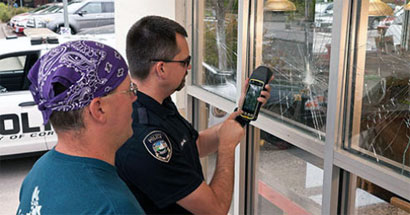
What all this means is that Trimble's Juno T41 represents a definite step forward into an era where workers on the job can enjoy smartphone-class functionality and ease of use instead of having to put up with dated technology and fumble with a little stylus. And it all comes in an industrial-grade device with industrial grade components.
|
|
|
 Specifications Trimble Juno T41 RFID
Specifications Trimble Juno T41 RFID
|
|
Status
|
Added 02/2014
|
|
Form-factor
|
Rugged handheld computer
|
CPU Speed
|
Texas Instruments DM3730, 800 MHz or 1 GHz
|
OS
|
Windows Embedded Handheld 6.5 or Android 4.1 "Jelly Bean"
|
RAM/ROM
|
512MB/8GB, 16GB, or 32GB Flash
|
Card slots
|
1 microSD card slot (up to 32GB), 1 SIM card slot
|
Display type
|
Outdoor-viewable color TFT LCD with Corning Gorilla Glass
|
Display size/res
|
4.3"/480 x 800 pixel
|
Digitizer/pens
|
Capacitive multi-touch, no pen
|
Keyboard/keys
|
On-screen, Windows: Windows and OK buttons, 2 soft buttons, volume up/down, on/off; Android: standard Android
|
Navigation
|
Touch
|
Housing
|
Polycarbonate plastic, rubber overmolding
|
Operating Temp
|
-22°F to 144°F (-30°C to 60°C),
|
Sealing
|
IP65 (yellow models) or IP68 (gray models)
|
Shock
|
4-foot transit drop per MIL-STD-810G, Method 516.6, Procedure IV
|
Humidity
|
90% relative humidity between 22 and 144°F per, MIL-STD-810G, Method 507.5, Procedure II
|
Vibration
|
General minimum integrity and loose cargo tests, MIL- STD-810G, Method 514.6, Procedure I & II, Category 5
|
Altitude
|
15,000 feet t 73°F to 40,000 feet at -22°F per MIL-STD-810G, Method 500.5, Procedure I, II & III
|
Solar Exposure
|
Survives prolonged UVB exposure, MIL-STD- 810G, Method 505.5, Procedure II
|
Chemical Exposure
|
Resistant to mild alkaline and acid cleaning solutions, fuel hydrocarbons, alcohols and common vehicle and factory machine lubricants
|
Certifications
|
FCC, CE, R&TTE, IC (Canada), A-tick, C-tick, GCF compliant, RoHS compliant, Section 508 compliant, PTCRB, SAR, AT&T network compatible, Wi-Fi Alliance certified, CCX, USB 2.0 Full Speed, MIL-STD-810G, IP65/IP68, MIL-STD-461E.
|
Size (WxHxD)
|
3.2 x 8.26 x 1.26 inches (82 x 210 x 32 mm)
|
Weight
|
Est. 18 ounces
|
Power
|
Internal 11.1 Volt 2,500mAH Li-Ion, 27.8 watt-hours
|
Sensors
|
Accelerometer, eCompass, ambient light
|
Interface
|
3.75mm audio jack, MCX GPS antenna port; custom port that supports USB 2.0 Host, USB Client, 9-pin serial and power
|
RFID
|
Ultra-High Frequency RFID either 902-928/920-926MHz (US, Canada, Australia, New Zealand) or 865.6-867.6MHz (Europe)
|
GPS
|
2-4 meter accurcy or optional 1-2 meter real-time accuracy with no post processing or subscription fees; MCX port for optional external antenna
|
Wireless
|
Bluetooth 2.1 + EDR, 802.11b/g/n WiFi, optional 3.75G (UMTS / HSPA+, GSM / GPRS/ EDGE, UMTS
Bands (WCDMA/FDD): 800, 850, 1900, AWS and 2100 MHz GSM Bands: 850, 900, 1800, 1900 MHz)
|
List price
|
R Models US$2,199 to US$3,149 depending on options
|
Warranty
|
2 years
|
Web
|
Juno T41 family page
|
Brochure
|
Juno T41 brochure (PDF)
|
|
 Trimble T41 R model
Trimble T41 R model
|
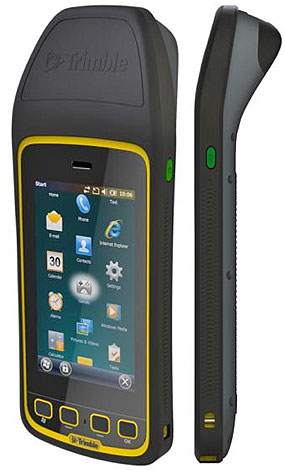
|
 RFID basics
RFID basics
|
Reading Electronic Product Codes — RFID, which stands for Radio Frequency Identification, is a technology where a reader communicates with a tag attached to an item via radio waves.
Active and passive tags — there are passive tags that simply respond when a reader signal is sensed. Those are inexpensive and do not need their own power source. There are also active tags that use their own power, resulting in longer read distances. There's also a differentiation between read-only tags, and tags that can be written to, either appending existing data, or overwriting data.
Different frequencies — note that RFID uses a variety of radio technologies. There are low (LF), high (HF), and Ultra-High (UHF) frequency readers, with each having is pros and cons. For mobile data capture applications, UHF RFID is usually best as it has a longer read range (up to 30 feet) than LF (under a foot) and HF (up to three feet).
Replacing bar codes? — will RFID—which is very fast and does not rely on line-of-sight—replace bar codes? Probably not. Both technologies will likely co-exist, it's just a matter of picking the right one for an application.
The EPCglobal Gen 2 RFID standard — EPCGlobal is an organization dedicated to worldwide adoption and standardization of electronic product code technology. The EPC, which consists of a barcode and a set of numbers, replaces the old UPC (Universal Product Code). EPCGlobal Gen 2 defines the design parameters for both readers and tags for RFID systems operating in the 860 to 960 MHz range. Among Gen 2 features is a "dense reader" mode that precludes interference or duplicate reads in situations where readers are operated close together.
|
 Trimble Juno T41 C model
Trimble Juno T41 C model
|
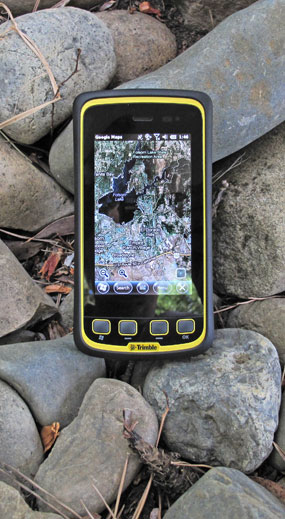
|
 Trimble Juno T41 G model
Trimble Juno T41 G model
|
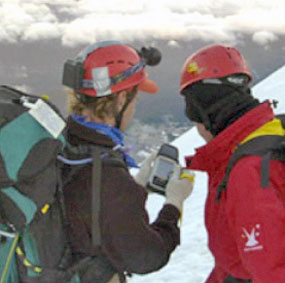
|
 Trimble MCS Contact
Trimble MCS Contact
|
|
| |
|
Trimble MCS
4100 SW Research Way
Corvallis, OR 97333
1-541-750-9200
mcs.trimble.com
|
|



